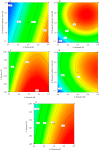Assessment of Encapsulated Probiotic Lactococcus lactis A12 Viability Using an In Vitro Digestion Model for Tilapia
- PMID: 38998093
- PMCID: PMC11240612
- DOI: 10.3390/ani14131981
Assessment of Encapsulated Probiotic Lactococcus lactis A12 Viability Using an In Vitro Digestion Model for Tilapia
Abstract
Probiotics face harsh conditions during their transit through the gastrointestinal tract (GIT) of fish because of low-pH environments and intestine fluid. Therefore, the evaluation of probiotic viability under simulated gastrointestinal conditions is an important step to consider for probiotic supplementation in fish feed prior to in vivo trials. Therefore, this study aimed to evaluate the effect of stomach and intestinal simulated conditions on the viability of encapsulated Lactococcus lactis A12 using an in vitro digestion model for tilapia. A Box Behnken design was used to evaluate the potential effect of three factors, namely stomach pH, residence time in the stomach, and enzyme quantity, on the viability of encapsulated Lactococcus lactis A12. As the main results, low pH (4.00), long residence time (4 h), and enzyme quantity (2.68 U of total protease activity) led to lower final cell counts after the phases of the stomach and intestine. Encapsulated probiotic bacteria showed higher viability (p < 0.05) and antibacterial activity (p < 0.05) against the pathogen Streptococcus agalactiae than non-encapsulated bacteria. The results suggest that L. lactis A12 survives in GIT conditions and that the proposed in vitro model could be used to explore the viability of probiotic bacteria intended for fish feed supplementation.
Keywords: Lactococcus lactis; Nile tilapia; digestion; encapsulated; in vitro; probiotic.
Conflict of interest statement
The authors declare no conflicts of interest.
Figures





Similar articles
-
Encapsulation improves viability and stability of spray-dried Lactococcus lactis A12 for inclusion in fish feed.PLoS One. 2025 May 27;20(5):e0323000. doi: 10.1371/journal.pone.0323000. eCollection 2025. PLoS One. 2025. PMID: 40424401 Free PMC article.
-
Effects of dietary Lactobacillus rhamnosus JCM1136 and Lactococcus lactis subsp. lactis JCM5805 on the growth, intestinal microbiota, morphology, immune response and disease resistance of juvenile Nile tilapia, Oreochromis niloticus.Fish Shellfish Immunol. 2018 May;76:368-379. doi: 10.1016/j.fsi.2018.03.020. Epub 2018 Mar 14. Fish Shellfish Immunol. 2018. PMID: 29550602
-
Evaluation of dietary single probiotic isolates and probiotic multistrain consortia in growth performance, gut histology, gut microbiota, immune regulation, and infection resistance of Nile tilapia, Oreochromis niloticus, shows superior monostrain performance.Fish Shellfish Immunol. 2023 Sep;140:108928. doi: 10.1016/j.fsi.2023.108928. Epub 2023 Jul 7. Fish Shellfish Immunol. 2023. PMID: 37423403
-
Probiotics in tilapia (Oreochromis niloticus) culture: Potential probiotic Lactococcus lactis culture conditions.J Biosci Bioeng. 2022 Mar;133(3):187-194. doi: 10.1016/j.jbiosc.2021.11.004. Epub 2021 Dec 15. J Biosci Bioeng. 2022. PMID: 34920949 Review.
-
Lactococcus lactis, a bacterium with probiotic functions and pathogenicity.World J Microbiol Biotechnol. 2023 Sep 30;39(12):325. doi: 10.1007/s11274-023-03771-5. World J Microbiol Biotechnol. 2023. PMID: 37776350 Review.
Cited by
-
Improving the survival under gastric conditions of a potential multistrain probiotic produced in co-culture.AMB Express. 2025 Feb 6;15(1):20. doi: 10.1186/s13568-024-01810-4. AMB Express. 2025. PMID: 39915371 Free PMC article.
-
Encapsulation improves viability and stability of spray-dried Lactococcus lactis A12 for inclusion in fish feed.PLoS One. 2025 May 27;20(5):e0323000. doi: 10.1371/journal.pone.0323000. eCollection 2025. PLoS One. 2025. PMID: 40424401 Free PMC article.
References
-
- FAO . The State of World Fisheries and Aquaculture 2024. FAO; Rome, Italy: 2024.
-
- Zarantoniello M., Bortoletti M., Olivotto I., Ratti S., Poltronieri C., Negrato E., Caberlotto S., Radaelli G., Bertotto D. Salinity, Temperature and Ammonia Acute Stress Response in Sea Bream (Sparus aurata) Juveniles: A Multidisciplinary Study. Animals. 2021;11:97. doi: 10.3390/ani11010097. - DOI - PMC - PubMed
-
- del Valle J.C., Bonadero M.C., Fernández-Gimenez A.V. Saccharomyces cerevisiae as Probiotic, Prebiotic, Synbiotic, Postbiotics and Parabiotics in Aquaculture: An Overview. Aquaculture. 2023;569:739342. doi: 10.1016/j.aquaculture.2023.739342. - DOI
-
- Ibrahim M., Ahmad F., Yaqub B., Ramzan A., Imran A., Afzaal M., Mirza S.A., Mazhar I., Younus M., Akram Q., et al. Antibiotics and Antimicrobial Resistance Genes in the Environment. Elsevier; Amsterdam, The Netherlands: 2020. Current Trends of Antimicrobials Used in Food Animals and Aquaculture; pp. 39–69. - DOI
Grants and funding
LinkOut - more resources
Full Text Sources
Research Materials

